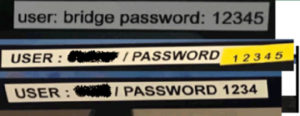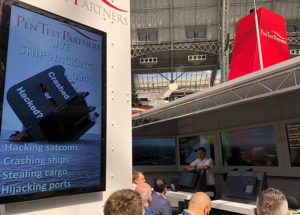Pen Test Partners’ Ken Munro and his colleagues – some of which are former ship crew members who really understand bridge and propulsion systems – have been probing the security of ships’ IT systems for a while now and the results are depressing: satcom terminals exposed on the Internet, admin interfaces accessible via insecure protocols, no firmware signing, easy-to-guess default credentials, and so on.
“Ship security is in its infancy – most of these types of issues were fixed years ago in mainstream IT systems,” Pen Test Partners’ Ken Munro says, and points out that the advent of always-on satellite connections has exposed shipping to hacking attacks.
A lack of security hygiene
Potential attackers can take advantage of poor security hygiene on board, but also of the poor security of protocols and systems provided by maritime product vendors.
For example, the operational technology (OT) systems that are used to control the steering gear, engines, ballast pumps and so on, communicate using NMEA 0183 messages. But there is no message authentication, encryption or validation of these messages, and they are in plain text.
“All we need to do is man in the middle and modify the data. This isn’t GPS spoofing, which is well known and easy to detect, this is injecting small errors to slowly and insidiously force a ship off course,” Munro says.
They found other examples of poor security practices in a satellite communication terminal by Cobham SATCOM: things like admin interfaces accessible over telnet and HTTP, a lack of firmware signing and no rollback protection for the firmware, admin interface passwords embedded in the configuration (and hashed with unsalted MD5!), and the possibility to edit the entire web application running on the terminal.
They shared this with the public because all these flaws can be mitigated by setting a strong admin password, but they also found other issues that have to be fixed by the vendor (and so they disclosed them privately).
Electronic chart systems are full of flaws
ECDIS – electronic chart systems that are used for navigation – are also full of security flaws. They tested over 20 different ECDIS units and found things like old operating systems and poorly protected configuration interfaces. Attackers could ‘jump’ the boat by spoofing the position of the GPS receiver on the ship, or reconfigure the ECDIS to make the ship appear to be wider and longer than it is.
“This doesn’t sound bad, until you appreciate that the ECDIS often feeds the AIS [Automatic Identification System] transceiver – that’s the system that ships use to avoid colliding with each other,” Munro noted.
“It would be a brave captain indeed to continue down a busy, narrow shipping lane whilst the collision alarms are sounding. Block the English Channel and you may start to affect our supply chain.”
Tracking vulnerable ships
Pen Test Partners also created a vulnerable ship tracker by combining Shodan’s ship tracker, which uses publicly available AIS data, and satcom terminal version details.
The tracker does not show other details except the ship’s name and real-time position because they don’t want to help hackers, but it shows just how many vulnerable ships are out there.
Hacking incidents in the shipping industry
Hacking incidents affecting firms in the shipping industry are more frequent than the general public could guess by perusing the news. Understandably, the companies are eager to keep them on the down-low, if they can, as they could negatively affect their business competitiveness, Munro recently told me.
Some attacks can’t be concealed, though. For example, when A.P. Møller-Mærsk fell victim to the NotPetya malware, operations got disrupted and estimated losses reached several hundred millions of dollars.
That particular attack thankfully did not result in the company losing control of its vessels, but future attacks might lead to shipping security incidents and be more disruptive to that aspect of companies’ activities.
“Vessel owners and operators need to address these issues quickly, or more shipping security incidents will occur,” he concluded.



